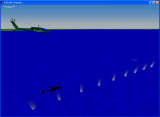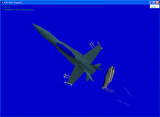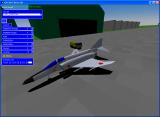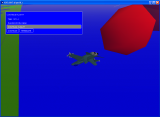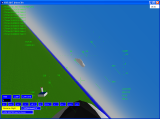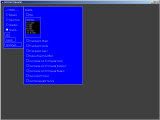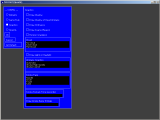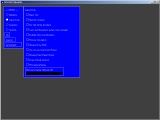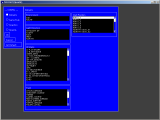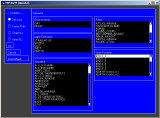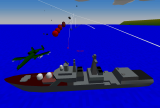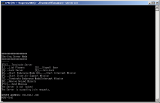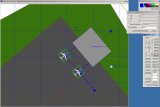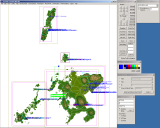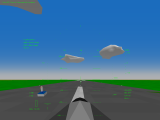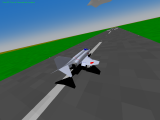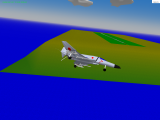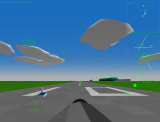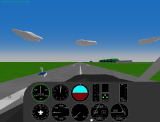|
|
| PAST UPDATES | |||||||||||||
|
04/06/2009 Additional screenshots of the coming version. In the next version, some maps will have distinction of water and land. In scenery editor, you will be able to specify the default area type (water/land), and specify local area type by enclosing a polygonal region by a motion path. Probably, (unless I get a big chunk of free time, which may not be very good for me), only difference that the area type makes in the next version will be plume of water when you shoot something into the water. (Bomb will have less power if it is dropped into the water.) However, this addition is needed to include seaplanes and user-controllable ground vehicle in the future versions. 03/29/2009 Two screenshots of the recently added functionalities (for the coming version) Below are two more screenshots of the recently added functionalities. The YSFLIGHT program was assuming that the fuel and ammo never increases after the airplane starts flying. So, it took substantial programming to implement these features.
10/05/2008 A screenshot of flight-replay mode of the coming version. In the next version, you can resume your flight anywhere in the flight record. (Other airplanes only fly pre-recorded path though.) This function allows you to, for example, practice a specific phase of landing. If you have difficulty in aligning an airplane to the runway, you can start from the base leg, or if you want to practice round out and flare intensively, you can start from final. Or, if you screw up while making a six-ship formation aerobatic flight by flying six times, you can resume the flight from anywhere you screw up. 09/20/2008 More screenshots of the new GUI I have roughly double the amount of duty compared to last year. So, YSFLIGHT development is going slowly like a turtle. But, I was able to do some more programming. I have been working on new GUI for the next version, and now pull-down menus are drawn by YSFLIGHT's own GUI library. Means menus are now also independent from Windows API. In the next version, the Linux version will have the same menu as the Windows version. You can see some screenshots below (click to enlarge). These screenshots are created in Linux.
04/30/2008 Preview of Next Version GUI Recently, I receive increasing number of comments and requests on Linux version of YSFLIGHT. I suppose many people switched to Linux rather than Windows Vista. It is understandable because Windows Vista is such a disaster. (Most of the E-Mails are regarding Windows version though.) By the way, I helped some friends setting up Vista on their PCs, but I swear I stick with XP until it becomes absolutely necessary to abandon XP. I wish Microsoft ships something usable by then. You know, such a CPU/Memory-hungry operating system ends up with consuming more electricity and bad for global warming, too. Right now, dialogs of the Linux version is sort of crap. It is because I was using Win32API to create dialogs in the Windows version, and I didn't have a Win32API-compatible GUI library for Linux that I could use for free. I am aware of some commercial GUI libraries that can be used exactly the same on both Windows and Linux, but I don't want to pay for it. So, I decided to write my own. Here are some screenshots.
I'm testing on Windows, but these GUI items are drawn only by YSFLIGHT's 2D-drawing functions. So, you will see almost exactly the same dialogs in Linux, too.
Well, it still doesn't look fancy, but will give adequate functionality. I will use same code for field selection, airplane selection etc. So, GUI will be better in the next version. Now it relies on YSFLIGHT's 2D-drawing functions, but it is easy to separate it and make a OpenGL GUI library. I may make it available for free in the future, just like my absolutely-free & no-string-attached C++ PNG decoder. One more change of the new version is the name. I changed the name from "YS FLIGHT SIMULATION SYSTEM 2000" to simply "YS FLIGHT SIMULATOR". Actually, why I called it a "Simulation System" was because I initially had a plan of making various types of flight simulators by using YSFLIGHT as a kernel. So, in the initial plan, Endurande Mode, Intercept Mission, and Close Air Support Mission were supposed to be separate programs. And, "2000" was added because when I made it (in 1999), 2000 was cool. You know, like Microsoft was selling "Windows 2000". So, "2000" didn't have a significance. (Clearly, I never expected this program lives so long.) However, the initial plan was meaningless because I ended up with putting everything in one program, and it is already year 2008, so "2000" is no longer cool. So, I decided to change the name to "YS FLIGHT SIMULATOR." By the way, although I dropped "Simulation System" from its name, I'm planning to add a plug-in capability by using DLLs in YSFLIGHT in the next version that hopefully comes later this year (but, it could be next year if I get sudden tasks like last year.) I have already started testing some plug-in features in Windows. I'm in process of learning how to build Shared Library in Linux, but hopefully I can add the capability in Linux, too. What surprised me the most after releasing YSFLIGHT was the creativity of the users. Users, like you, came up with the ways of enjoying my program that I had never imagined. I was really impressed by that. Nowadays, Visual Studio .NET Express Edition is available for free. So, if I make a way to expand the program by C++, I expect some of you will surprise me again with ideas that I never imagined. YSFLIGHT 20080220 version is ready for download! You can download the program from this link. Major changes are as follows:
Please wait for the new Linux version for a few more days. 09/22/2007 Udaloy-Class Destroyer I've made a model of Udaloy-Class Destroyer. If no new task does not come up, I'm planning to start next test phase late October. 09/10/2007 One more screen shot This thing will also be added in the next release. 09/07/2007 More on Scenery Editor You will be able to put aircrafts in the scenery with the next version of Scenery Editor. Now the program cannot assign a complex mission, but the program will be able to export .YFS file so that you can manually edit the file to make your own. 08/30/2007 Here are some screenshots of the coming version of Scenery Editor. I'm planning to release the next version with the next version of YSFLIGHT. The visible change is the auto arrangement of the dialogs. In the previous versions, the dialogs appears on top of others, and not very well organized. In the next version, dialogs will be automatically located on the right of the main window (or on the right side of the monitor if there is not enough space.) Also, the next version will support editing of a high-elevation airport, object search, making rect-region that matches some map elements, making a motion path that passes exactly through a road drawn as a thick line, selecting nodes/faces of a elevation grid based on some conditions, etc. The above screenshot shows Northern Kyusyu map that I'm making right now. Original plan was just Nagasaki prefecture + Tsushima + Gotoh islands, but I ended up with adding Saga prefecture as well. I may add Fukuoka prefecture as well, but not decided. I purchased sectional charts of Japan for making more realistic Japan map when I visited Japan in may. So, the map includes VOR/DMEs and NDBs that really exist. 08/17/2007 Now experimenting You may think that above screenshots are nothing new. Look closely. The altimeter is showing about 1,000ft although the airplane is on the ground. In the previous versions, all ground airports needed to be at 0ft elevation (or, you needed to make a special ground object to make a non-zero elevation airport). But, in reality, an airport is usually at higher elevation. For example, Allegheny County Airport is at 1,250ft MSL, and some airports in mountains are even higher like 8,000 to 10,000ft MSL. In the next version, I'm thinking to support airports located at a higher elevation. The previous versions assumed that all maps were drawn at sea level (i.e. 0ft MSL) This assumption allowed to omit a lot of calculations so that maps are drawn quickly. However, this assumption is not applicable if some airports are at higher elevation, and some object at lower elevation could be seen through the ground unless I modify the algorithm. I came up with a nice solution to this problem and am thinking to implement it in the next version. The implementation is not complete yet, and you see one polygon which is not supposed to be seen in the third (right) screenshot. 08/03/2007 Navigation Instruments It probably is difficult to see what are different from the latest release, but I'm now working on making the navigation equipments more realistic. In the current version, ILS and VOR are implemented as two separate instruments. However, ILS is a special form of VOR and is usually shown on a VOR instrument. If you tune to ILS, your VOR instrument will show the glide slope and localizer, or if you tune to a VOR station, your VOR instrument will show the course deviation. In the current version of YSFLIGHT, you can only turn on/off ILS, and the ILS will automatically tune to the nearest ILS signal. But, it was not very convenient, like when you approach runway 8L of Honolulu International from the south, you will see the ILS information of 8R first, then suddenly it changes to 8L. And, in a real airplane, we often use two VORs to find the exact location of the airplane. However, since there was only one VOR instrument, such a technique was unavailable in YSFLIGHT. I'm now modifying the program so that you can use two VORs, and each of them can work as either an ILS or a VOR indicator, and you can select the station by menu. (Only NAV1 will be able to show glide slope though.) Another feature I'm planning to implement is ADF, which stands for Automatic Direction Finder. ADF is a simple instrument that shows a relative direction to a radio beacon called NDB, which stands for Non-Directional Beacon. It is pretty simple to go close to the NDB station. You can do it just by keeping the ADF needle pointing upward. You will need to take some wind-correction angle when the wind is strong, but anyway you can come somewhat close to the station if you keep the needle pointing upward. However, when you want to navigate the airplane precisely solely by ADF, things get complicated. First of all, ADF is not accurate. Especially when you are far from the NDB station, the ADF needle swings left and right, and does not give an accurate direction. Even after the needle is stable (when you come close to the NDB station) intercepting and tracking a specific course by ADF without drawing a diagram on a map is not so easy. So, now ADF navigation is less and less used. Nonetheless, it would be an interesting addition to YSFLIGHT. 05/27/2007 I meant to run a YSFLIGHT server during the memorial-day weekend, but
I forgot starting the server when I left my office on Friday. Now
I started it, and you can use it freely. The IP address of the
server is 04/27/2007 I keep the server up during Japanese long holiday (called Golden
Week.) The IP address of the server is
04/23/2007 YSFLIGHT 20070415 Version is ready for download! YSFLIGHT 20070415 Version is ready for download! (Linux version will follow soon.) Click here to go to the download page. New features are as follows.
I have received a lot of bug reports during the test period. Thank you very much for your help. I could not take all the requests I have received, but I will try to address those requests in the future versions. 04/06/2007 About Non-OpenGL version Actually, I was thinking to stop upgrading Non-OpenGL version. I started developing YSFLIGHT in 1998, when I was desperately studying to pass the Ph.D qualifying exam. I was studying (sort of) computer science during my undergrad and masters degree, but I changed my major to mechanical engineering for Ph.D. I had to pass the Ph.D qualifying exam in 1.5 years. That was the biggest challenge of my life so far. I was studying at least 10 hours per day excluding time for eating and taking break. However, I couldn't sustain 10-hours-per-day study without doing something fun. One of my biggest hobbies was programming, and I started writing YSFLIGHT then. In that time, Non-OpenGL version was the main part, and OpenGL version was sort of appendix. No graphics card of that era supported OpenGL hardware acceleration. So, CPU was doing everything to draw the 3D scene. CPU was also slow, and it was virtually impossible to draw OpenGL-quality pictures fast enough for comfortably playing a flight simulator. Non-OpenGL version was (and is) doing everything by CPU. However, because of its lower-quality graphics, it skips a lot of computation, and even then Non-OpenGL version was fast enough for comfortable flight-simulator playing. However, the era has changed. Nowadays, except those laptops specially designed for office use (deliberately excluding 3D acceleration capability so that employees do not play games on it :-P) virtually all graphics card support OpenGL acceleration. It means that the CPU sends some commands of drawing a 3D scene to the graphics card, and then it can forget about drawing and concentrate on aerodynamics computation etc. While CPU is doing those computations, the graphics card draws a 3D scene. So, drawing and computation go simultaneously. And, since the graphics hardware is specialized for 3D graphics, it is much faster than CPU in drawing a 3D scene. I'm trying to make YSFLIGHT playable comfortably with 3-year old PC, but GeForce4 was already available 3 years ago. The reason to maintain Non-OpenGL version was fading, that's what I was thinking until I received an E-Mail a few weeks ago. The E-Mail came from an army officer serving in Iraq. According to his E-Mail, he did not carry his own laptop to Iraq because he did not know for sure about the environment there. He didn't want to risk his laptop. He purchased an used laptop there. However, it was slow and impossible to play a commercial flight simulator on it. However, only the Non-OpenGL version of YSFLIGHT worked with no frustration on his laptop. I never imagined this situation. I can only imagine that he is serving in Iraq, away from home, under tremendous stress. It was very good to know that my program gives him some time to relax, and now I feel it is a good reason to continue developing Non-OpenGL version. So, I'll continue upgrading Non-OpenGL version for a while. 03/24/2007 I need to admit that this page has been dysfunctional :-P I try again to update this page more often and put more update information regularly, instead of putting all of them in the test-version page when I release a test version. I suppose you have already at least seen the test-version page, if not played yet. In this update, I focus on cleaning up and stabilizing the network functions, which became somewhat complex to accept connections from the older version. So, I don't add many new visual features in this one, but it is a necessary update for the future development. Please wait for the next update that will come later this year for some visible updates. I have a long to-do list that includes requests and comments I have received from many users. I really appreciate them. Other than that, I'm thinking about expanding its instrument flying feature. As I'm writing in CaptainYS's flight logbook, I'm now working on instrument rating (in a real airplane,) and I'm reading textbooks and study materials for instrument training. Those study materials clarified many things that I was wondering for years. I'll put those knowledge I gained through the study to the future versions of YSFLIGHT. In fact, instrument flying is interesting. I've just started the training, and I'm now in the phase I, which is practices of basic flight maneuvers under instrument condition. But, I have already tried to fly under IMC (Instrumental Meteorological Condition) in Microsoft Flight Simulator. It gives a good feeling when I see the approach light of the destination runway coming out of the fog. I added some element of Instrument Flying in the previous version of YSFLIGHT as Landing Practice mode. Probably, adding earlier stage of approach, like to navigating based on VOR until intercepting localizer, will be a great feature. Anyways, I try to use this web site more effectively from now on. (It was one of my new year's resolutions. Oh no! It's already late March.) [Past Update Log 2003-2006] [1998-2003]
|
|||||||||||||
|
Comments are welcome. Send E-Mail
to:
|
This page is link
free, but please link to
http://www.ysflight.com. Please use one of following
banners.

 |
